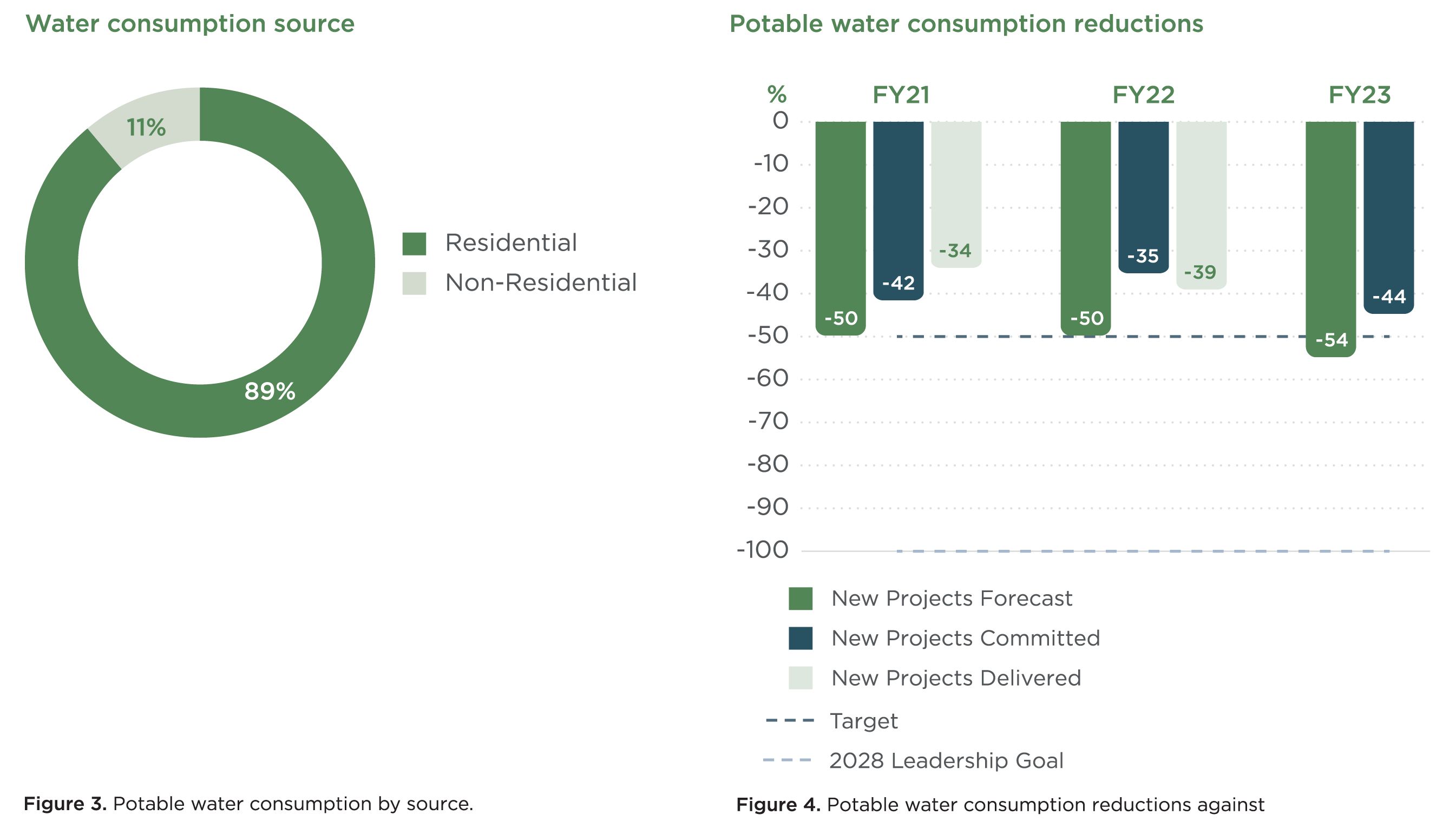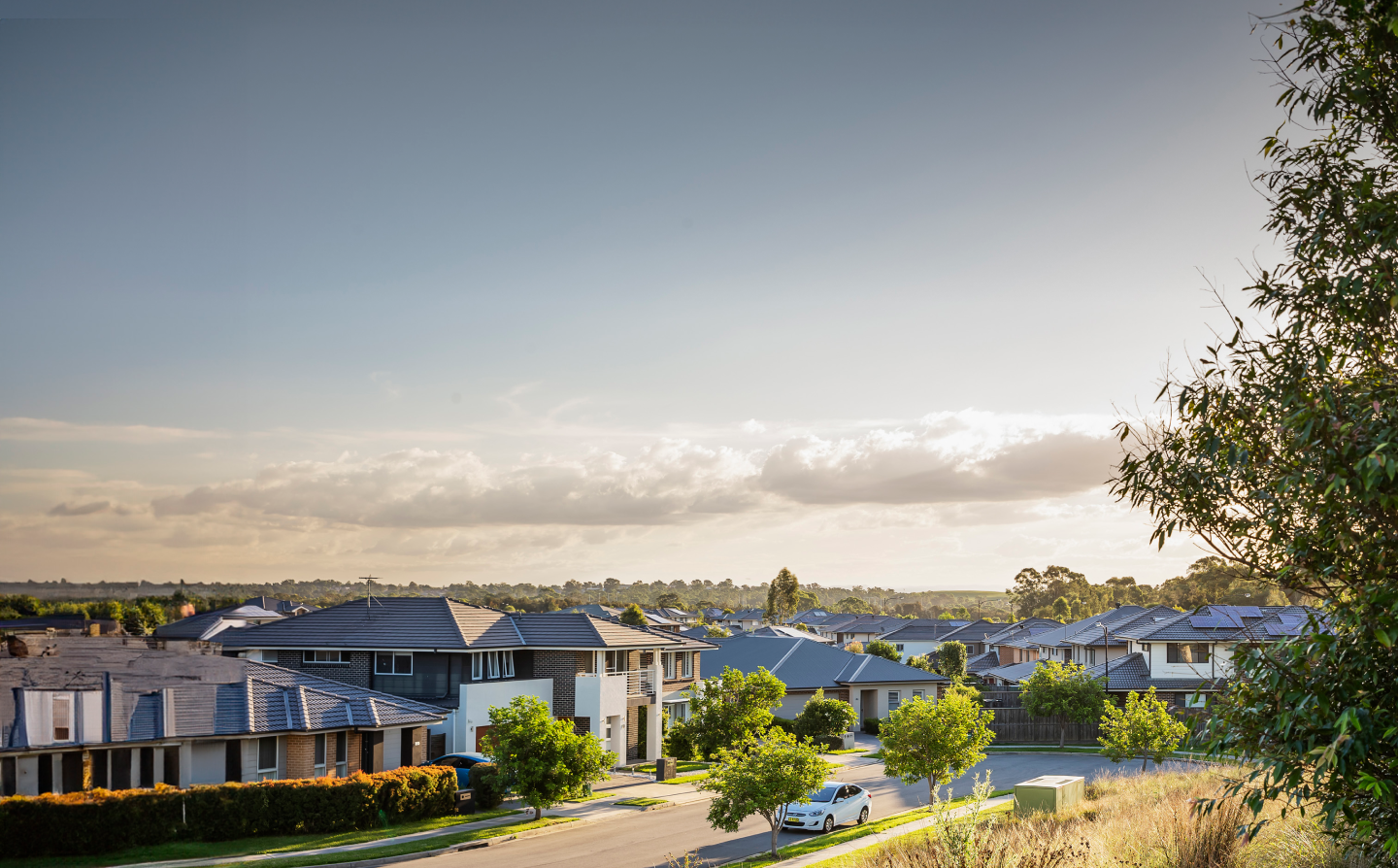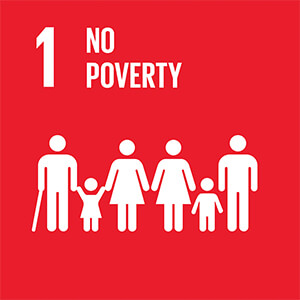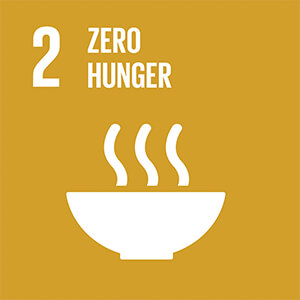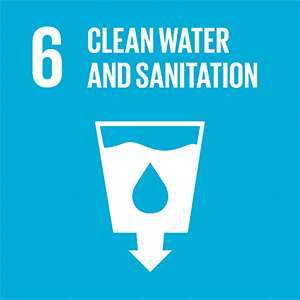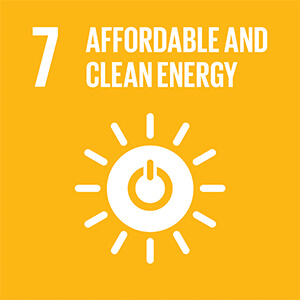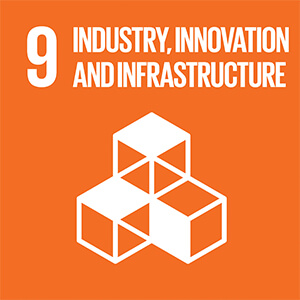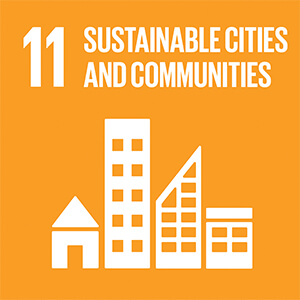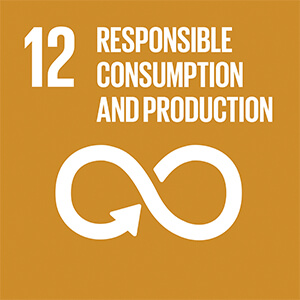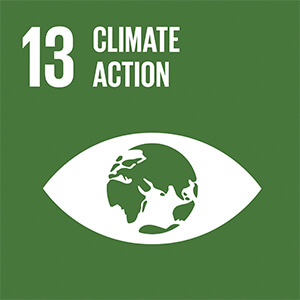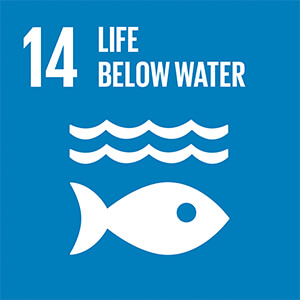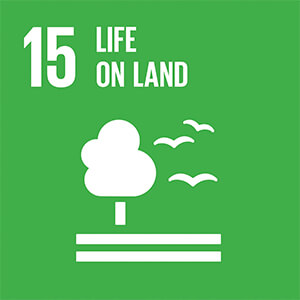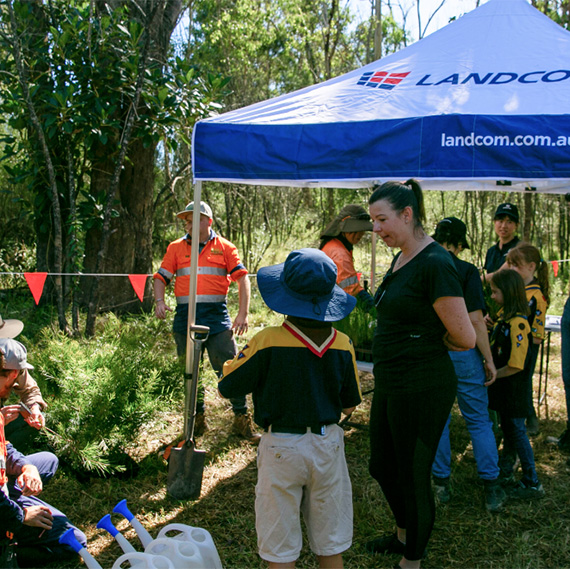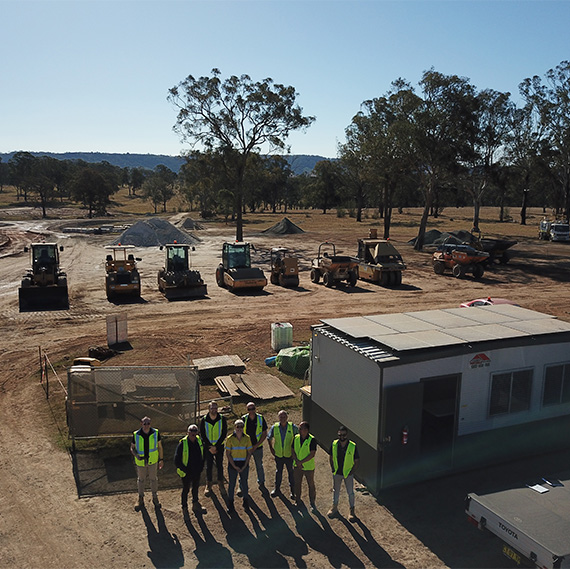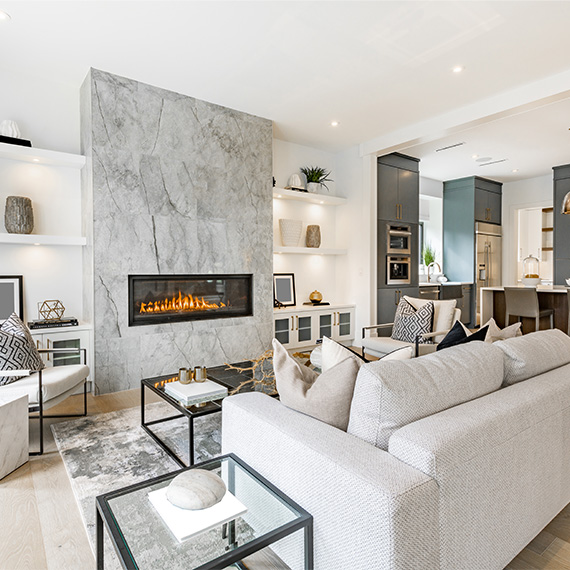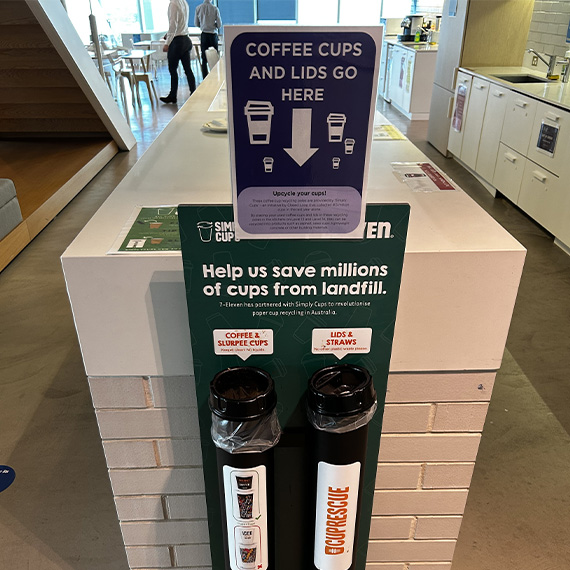Overview
This pillar is focused on our leadership goal to ‘enable carbon neutral, water positive, zero waste and net positive ecological communities by 2028’.
This leadership goal aligns to and supports the Paris Agreement, the United Nations Sustainable Development Goals, and the Task Force on Climate-related Financial Disclosures.
Within this pillar Landcom focuses on environmental sustainability and resilience. It encompasses environmental management and the adoption of independent third-party rating tools and certifications, engaging with our supply chain, supporting communities to reduce their operational costs of living, and developing our projects in a way that reduce impacts on the environment.
Environmentally sustainable communities are balanced in meeting the needs of the natural and urban environments. They take into account the needs of people today, and the needs of our future generations.
Landcom believes that the built environment should incorporate green spaces and retain a connection to our natural habitats, for the benefit of the environment, and our communities.
Landcom addresses environmental sustainability through the following focus areas:
- Climate & Resilience
- Energy & Emissions
- Environmental Management
- Waste & Materials
- Water
Each of these focus areas includes a suite of targets to measure our success.
Case Studies
Management Approach
Every Landcom project is unique and requires a bespoke approach to environmental sustainability. We use the sustainability modelling tool PRECINX to identify opportunities for performance improvement across our Energy & Emissions and Water targets.
Our approach to Energy & Emissions includes influencing the reduction of greenhouse gas (GHG) emissions (stationary and transport) at a precinct scale across our communities and influencing the onsite production of renewable energy.
From FY24 transport will be removed from our approach to modelling and reporting emissions at our communities. This is in response to our limited influence over transport emissions. We will continue to design communities to support active transport over car-dependent lifestyles, encourage the uptake of electric vehicles and work with our stakeholders to provide access to high-capacity transit options.
We approach Water in a similar way, by looking at the reduction of potable water use across a precinct and identifying opportunities for recycling and reuse. We also set ourselves targets to limit stormwater discharge pollutant loads from our sites. This minimises downstream water quality impacts in the communities we develop. Urban stormwater modelling software such as MUSIC1 is used to measure pollutant loads across our projects.
_________________________
1 In some instance, Landcom may use other rating tools in lieu of, or in addition to those outlined. This is at Landcom’s discretion.
We adopt independent third-party rating tools and certifications, or exceeding regulatory requirements. We believe it is important to have independent verification of our sustainability performance and this is reflected in our targets for Environmental Management. Our preferred rating tools are outlined below.

Green Star, administered by the Green Building Council of Australia, is Landcom’s preferred independent and voluntary rating tool for precincts and built form. We also adopt the National Australian Built Environment Rating System (NABERS) to validate the operational sustainability of eligible non-residential built form.
Through our targets review Landcom has maintained its commitment to adopting Green Star and NABERS targets for independent certification of communities and large buildings.
Historically we have measured the energy and water efficiency of homes in accordance with the Environmental Planning and Assessment Act (1979) Building Sustainability Index (BASIX)1. For many years Landcom has set above compliance BASIX targets. However, BASIX has recently been revised with a significant elevation in energy efficiency required of new homes from 1 October 20232. Therefore, this is no longer a need for Landcom to adopt higher than compliance BASIX Energy targets.
_________________________
1 About BASIX.
2 BASIX Review.
Landcom’s approach to Climate & Resilience includes understanding our physical, social and transition risks to climate change and its impacts, ensuring our communities and business are adaptable to change, addressing known risks such as urban heat island, and maintaining our commitment to enhancing local biodiversity and ecology.
For physical and social risks across projects we use our Resilience-In-Design checklist to consider common climate risks during the early phases of a project’s design, complete site-specific climate risk assessments for all new projects which are reported to management and adopt adaptation plans. Climate risks assessed include bushfire, drought, extreme heat, extreme rainfall and flooding, extreme storms and sea level rise. Understanding that the homes and infrastructure within our communities can have 50 year design lives, we use 2030, 2070 and 2090 time horizon climate projections where available to guide our understanding of future risk. The overall objective is to better understand the shocks and stresses our communities may be exposed to, understand which of those may have the most material or financial impact, adapt our approach to mitigate or minimise those impacts, and enhance the resilience of our communities now and into the future.
More broadly, our Climate Risk Management Plan governs transition risk management for Landcom. This includes a Task Force on Climate-related Financial Disclosures Business Case with ongoing action for delivery, as well as the inclusion of climate risk within the organisation Risk Appetite Statement.
Our Executive team and Audit & Risk Management Committee are updated twice a year regarding ongoing management of climate risks, or more frequently if necessary.
Strong biodiversity and ecological communities are essential to enabling resilience. Our 2028 leadership goal seeks to enable net positive ecological outcomes at the completion of our projects.
This is particularly important with upcoming global frameworks such as the Task Force on Nature-related Financial Disclosures and the Science Based Targets for Nature, as well as the need to pursue more nature-based solutions to support biodiversity enhancement and climate resilience.
We abide by legislative requirements including the Commonwealth Environmental Protection and Biodiversity Conservation Act 1999 (EPBC) and NSW Biodiversity Conservation Act (2016) when addressing areas of biodiversity.
When we purchase biodiversity offsets for our development approvals, we use the NSW State Government BioBanking Scheme which commits landowners to enhancing and protecting the biodiversity values of their land.
We use our Biodiversity Calculator to measure the quality and quantity of ecological communities beyond any legislative requirements, pre- and post-development, and continuously look for ways to reduce the impact of our activities on biodiversity, while also acknowledging that land development and retention of biodiversity are sometimes at odds.
Landcom’s Biodiversity Calculator is designed to measure the change in quality and quantity of biodiversity at a given project site, from pre-development to post development. The calculator goes beyond just assessing high-value and significant biodiversity (which legislation requires to be conserved) and factors a broader spectrum of biodiversity value into the assessment. Depending on the level of quality and quantity change, the calculator determines whether a net positive or net negative impact has been achieved. It is possible to have a net positive outcome in biodiversity, despite a reduction in physical area, if the quality of that area has been significantly improved.
In FY22 we expanded the use of our Biodiversity Calculator to address key biodiversity metrics under the Global Reporting Initiative such as consideration of International Union for Conservation of Nature (IUCN) ‘Red List’ species, areas of high value biodiversity, habitats protected or restored and significant impacts of our activities on biodiversity.
The scale provided by the Biodiversity Calculator is as follows:
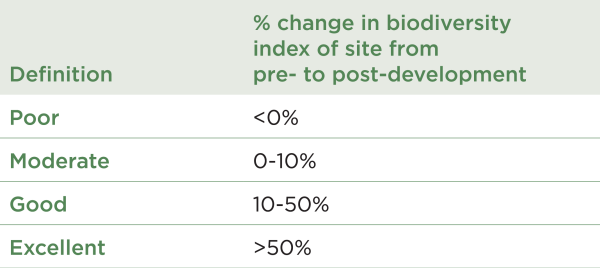
Landcom’s environmental leadership goal for 2028 includes enabling zero waste communities.
To do this we advocate for responsible use of resources, and diversion from landfill. In calculating our waste diversion from landfill target we exclude hazardous waste and contamination volumes from the figures to align more closely with the standards set out in the Green Star rating tools.
While we are focused on reducing waste within our own offices (refer Case Study: Office Waste) it is construction waste that is material to Landcom’s operations. As part of our ongoing commitment to reduce waste and increase responsible materials use, we continue to engage with our site superintendents and principal contractors to reduce, reuse or divert waste from landfill.
We also include the responsible sourcing of timber for all construction works within our approach. This increases engagement with our supply chain and supports work underway within our Accountable & Collaborative Places pillar.
Over the next few years we intend on looking at a range of priority areas, including:
- understanding Landcom’s role in regenerating or restoring biodiversity and local watersheds within our communities
- determining the value of adopting a Landcom materials Red List1
- establishing how life cycle assessments may improve our supply chain and reduce embodied carbon and waste at our projects.
In FY23 we continued our investigations into how Landcom can better deliver against our leadership goal within the areas we operate using the above opportunities, including piloting a number of actions both internally and at our communities. As we now understand the actions needed to deliver on our leadership goal, from FY24, we will have new targets in our Sustainable Places Strategy to reflect these changes and progress. These new targets are summarised on the following page.
_________________________
| Current | New |
|---|---|
| Climate & resilience | |
| All new projects undertake a Climate Resilience Assessment | Retire. |
| All new projects prepare and implement an effective climate adaptation and community resilience plan | All projects implement actions to address identified physical and transition climate risks. |
| All new projects enhance the local habitat, biodiversity or ecological communities, compared to the site conditions pre-acquisition or pre-master plan | Net positive biodiversity portfolio performance. |
| Total project site area in plan view comprised of building or landscape elements that reduce the impact of urban heat island effect | All projects achieve a net urban heat reduction. |
| All new built form adopts industry best practice Solar Reflective Index (SRI) minimums. | |
| Energy & emissions | |
| All new projects modelled to reduce greenhouse gas (GHG) emissions at a precinct scale (transport and stationary) by 50% against 2016 reference case | 70% GHG emissions weighted portfolio reduction. |
| 10% upfront and embodied carbon weighted portfolio reduction. | |
| 5% of predicted precinct energy demand supplied from onsite renewable energy, where site constraints permit | 20% forecast precinct energy demand is supplied by renewable energy, or a smart energy solution. |
| Environmental management | |
| All projects will adopt the use of industry recognised rating tools at a masterplan and built form scale, achieving not less than ‘Australian Best Practice’ | All projects achieve a certified Green Star rating. |
| NABERS: Office, hotel and retail – Commitment Agreement or designed to 5 Star Energy and Water | 5 Star NABERS ratings for all office, hotel and retail. |
| BASIX energy rating: Detached and semi-60, Low rise 55, Mid-rise 45, High rise 40 | All Landcom controlled dwellings achieve ‘Low’ BASIX materials rating. |
| All residential dwellings to achieve BASIX 60 water rating. | All Landcom controlled dwellings achieve BASIX 60 water. |
| Waste & materials | |
| All new projects divert minimum 95% construction waste from landfill (excl. contamination or hazardous materials) | 98% portfolio construction waste is diverted from landfill. |
| 80% portfolio demolition waste is diverted from landfill. | |
| 100% timber sourced for construction (by cost) is Forest Stewardship Council Certified or agreed equivalent (i.e. Australian Forestry Standards) | 100% of construction timber is industry certified. |
| Water | |
| Water Sensitive Urban Design (WSUD) pollutant discharge loads not to exceed N45, P65, SS85, GPT90. | Retire. |
| All new projects modelled to reduce mains potable water demand by 50% at the precinct scale, against 2016 reference case | All new projects demonstrate water positive outcomes through an Integrated Water Management Strategy (IWM) or a Water Balance study. |
Performance Results
See below our performance results for each of the reporting areas within our Climate Resilient Places Pillar.
Climate & Resilience
Targets
Performance
All new projects to undertake a Climate Resilience Assessment
Performance
FY22 Performance
18 out of 18
cumulative in-scope projects completeFY23 Performance
20 out of 20
cumulative in-scope projects completeTargets
All new projects prepare and implement an effective Climate Adaptation and Community Resilience Plan.
Performance
FY22 Performance
17 out of 18
cumulative in-scope projects completeFY23 Performance
18 out of 20
cumulative in-scope projects completeTargets
All new projects enhance the local habitat, biodiversity or ecological communities, compared to the site conditions pre-acquisition or pre-master plan (Landcom Biodiversity Calculator).
Performance
FY22 Performance
50%
cumulative in-scope projects completeFY23 Performance
100%
cumulative in-scope projects completeTargets
Total project site area in plan view comprised of building or landscape elements that reduce the impact of urban heat island effect
Greenfield Projects: 50% project site area
Renewal or High Density Projects: 20-50% project site area (calculation in accordance with Green Star Communities)
Performance
FY22 Performance
100%
of projects in scopeFY23 Performance
100%
of projects in scopePerformance Overviews
All our new in scope projects since the launch of the Sustainable Places Strategy, and all relevant legacy projects, now have climate resilience assessments in alignment with the IPCC AR5 Representative Concentration Pathways 4.5 and 8.5 climate projections, and 18 out of 20 communities have prepared adaptation plans to reduce the physical and social risks of climate change to the project and community. The remaining two communities have plans underway and are anticipated to be finalised in FY24.
‘Extreme risk’ from extreme heat is common to almost all Landcom sites and based on global projections, likely to increase in risk over the short, medium and long‑term. This finding confirms the importance of Landcom’s priority to reduce or mitigate the effects of urban heat island and build community resilience to heat at all new projects.
Bushfire is also a consistent ‘high risk’ across Landcom’s project portfolio, while sites across our portfolio are starting to also see increased ‘high risk’ due to extreme rainfall and flooding. We anticipate these physical risks and their influence on social outcomes will continue to increase in intensity and frequency into the future.
More broadly, Landcom strives to be an industry leader in responding to and disclosing climate risks in accordance with 11 TCFD Recommended Disclosures. Further detail on these efforts can be seen in Appendix B: Task Force on Climate-related Financial Disclosures (p.64).
In FY23 we matured our approach to transition risks. This isn’t captured in our project based targets, however is part of our organisational response to managing climate risk. During FY23 we progressed the four priority actions identified in our recent climate transition risks modelling. You can read about this in our Case Study: Transition Risk Priority Actions.
Heat continues to be a major stress for many cities across Australia, as confirmed by our climate change risk assessments. Landcom’s commitment to reduce urban heat island (UHI) effect will contribute to reduced risk of extreme heat at our projects. This will enhance the resilience of our communities and the residents who live there.
In FY23 Hillsborough, Wentworth Point, Bulli, North Tuncurry and the SMNW Places precincts of Hills Showground and Cherrybrook are in scope for our UHI Reduction target. A majority of these sites focus on retention of mature canopy trees and large stands of vegetation, while some of the smaller sites have included designs for green roofs and podiums and increased plantings along the street verge.
Projects in scope for FY23 included Hillsborough, Wentworth Point, Cherrybrook and North Tuncurry, all of which are currently making a net positive biodiversity contribution.
Overall, a total of 476.19 hectares will be protected and restored by National Parks, local councils or other entities aligned with legislative guidelines. This supports improved outcomes considering that two of our projects have Commonwealth-listed protected species or habitat, while the other two projects have NSW-listed protected species or habitat and this protection will afford the opportunity for these species to thrive.
North Tuncurry, in particular, is forecast to contribute a very good (87.15%) net positive change in biodiversity value, due to the project retaining and enhancing 318.24 hectares of non-certified native habitat, including the 4 hectare Tuncurry Midge Orchid (TMO) conservation park alongside 379.62 hectares of native habitat offsets managed in perpetuity under an offsite Biodiversity Stewardship Agreement.
All four of the projects however will result in the removal of native vegetation, two of which will result in the removal of species habitat. While one of the projects will have potentially irreversible impacts to threatened species, with increased restoration, native landscaping and plantings we can return a positive outcome and reduce our overall impact.
Indirect risks such as transport of weeds and/or pathogens and inadvertent impacts on adjacent habitat or vegetation are possible during development of our communities, however we continue to effectively manage this risk through the preparation of robust Environmental Management Plans.
As part of our Future Priorities, Landcom is investigating methods of restoration or regeneration onsite to further reduce the potential impacts on species, vegetation and habitat and contribute towards our goal of all projects enabling a net positive ecological outcome.
IUCN Red List and national conservation list species within habitat affected by our operations are listed in the following table.
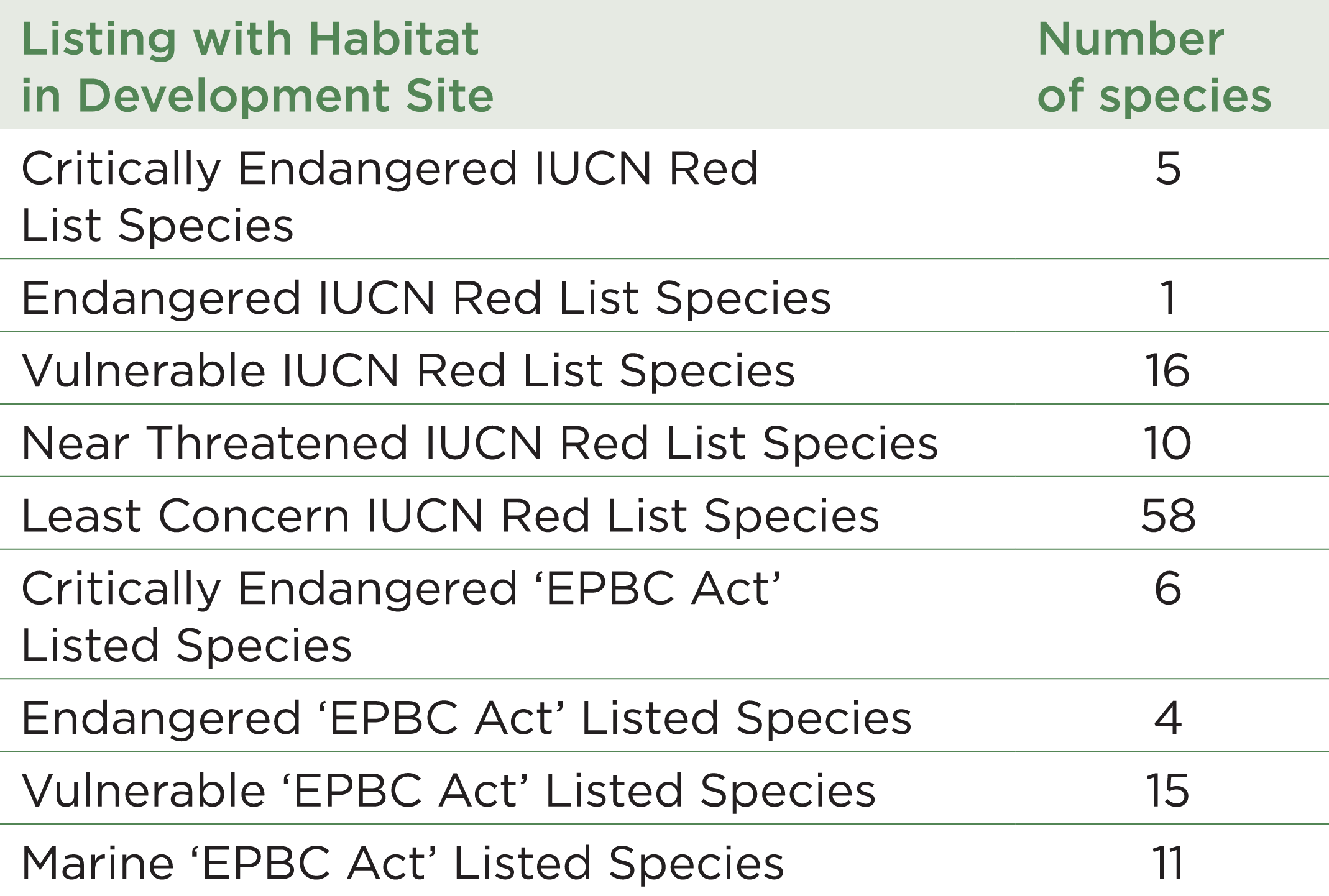
The average change from pre-development to post‑development across all four projects for FY23 is forecast to be a good (36%) positive change in biodiversity value, with 70% of the site area across all projects contributing to biodiversity.
Wentworth Point is forecast to contribute a moderate (22.64%) positive change in biodiversity value, with 55% of the site identified to contribute to the biodiversity outcome. All of the significant habitat (in good condition) has been retained on site while 0.36 hectares of significant habitat (in poor condition) will be restored, enhancing the habitat for local species and improving its overall biodiversity value.
Hillsborough is also forecast to contribute a moderate (9.48%) positive change in biodiversity value, driven by the retention and restoration of 25.67 hectares of significant habitat (66% of the site area) that will be managed in perpetuity under a Biodiversity Stewardship Agreement.
All of the four projects have protected, or restored areas present within their development boundary, including three with a Vegetation Management Plan. Although Cherrybrook is yet to finalise a management plan for biodiversity, it is still forecast to contribute a moderate (9.48%) net positive change in biodiversity value and we can expect the biodiversity value to improve even more when a management plan is in place.
The Cherrybrook site is co-located with a metro station delivered by Transport for NSW. Transport for NSW is also the landowner of these projects, and Landcom has been appointed as the master developer for the surrounding communities.
As Landcom is not the landowner of the SMNW Places sites, management of biodiversity offsets and other approvals is beyond our operational control and is undertaken by Transport for NSW. Landcom will continue to review opportunities to elevate the performance of SMNW Places sites through project divestment and delivery strategies. At each of these projects native habitat offsets will be employed to manage any reduction in habitat area.
Energy & Emissions
Targets
Performance
All new projects modelled to reduce Greenhouse Gas (GHG) emissions at a precinct scale (transport & stationary) by 50% against 2016 reference case (CCAP PRECINX).
Performance
Delivered:
FY22 Performance
28%
portfolio weighted reductionFY23 Performance
No delivered projectsCommitted:
FY22 Performance
20%
portfolio weighted reductionFY23 Performance
42%
portfolio weighted reductionForecast:
FY22 Performance
39%
portfolio weighted reductionFY23 Performance
39%
portfolio weighted reduction5% of predicted precinct energy demand supplied from onsite renewable energy, where site constraints permit.
Delivered:
FY22 Performance
100%
FY23 Performance
100%
Committed:
FY22 Performance
100%
portfolio weighted reductionFY23 Performance
100%
portfolio weighted reductionOur emissions reduction target seeks to minimise stationary and transport emissions through the adoption of energy efficient design, renewable energy infrastructure, transport mode split and parking strategies, and uses incentives to encourage efficient building systems and appliances.
The emissions reported are the predicted operational emissions of a masterplan at completion and are calculated using the sustainability modelling tool PRECINX and a NSW metro average baseline of 2016. The global warming potential account factors align with the National Greenhouse and Energy Reporting (NGER) Act.
In FY23 our projects with development applications approved, contracts exchanged or design decisions made, final approvals or construction underway enabling a ‘committed’ result to be reported include SMNW Places precinct at Norwest, Macarthur Gardens North, North Wilton, Schofields and Queenscliff.
Collectively their average emissions reduction is 42% against the 2016 metro average. Of note, Norwest achieves a 50% committed reduction, Queenscliff achieves a 58% committed reduction and North Wilton achieves an 85% committed reduction.
Landcom will continue to identify opportunities at our sites to further improve energy performance and reduce GHG emissions. When future development planning approvals are provided by relevant consent authorities for these precincts, and Landcom settles on the projects, we will report any shift between the commitments made by the proponents, and the actuals achieved (reported as ‘delivered’). There were no projects in scope this year to be articulated as ‘delivered’.
New projects, or individual precincts within ongoing projects currently in the planning and design stages, are also in scope for FY23 reporting. Forecast results include the SMNW Places precincts of Kellyville, Bella Vista and Cherrybrook, plus Edmondson Park, Austral, Wentworth Point, Bulli and Hillsborough which achieved a weighted average GHG emissions reduction of 39% (see Figure 1).
Higher-density projects continue to present the greatest challenge in attaining material emissions reductions, due to the reduced site area and roof space available to incorporate renewable energy technologies in a cost-effective way. Conversely, our newer lower-density projects, such as at Bulli, are forecast to exceed our emissions targets with an 84% reduction due to the increased uptake and size of solar PV systems.
In FY23 transport has risen to be our most material forecasted emissions source, followed by residential emissions and then non-residential land uses. Non-residential emissions continued to remain high in FY23 as a material emission source due to the inclusion of the Bella Vista precinct and Wentworth Point which both have a considerable portion of non-residential land uses (see Figure 2). The increase in the proportion of transport emissions reflects uptake of energy efficient appliances and increased penetration of renewables which helps reduce our residential emissions.
While our emissions target is designed to address new projects, in FY23 we continued to seek opportunities to make a meaningful impact on projects that have already moved through the planning and design phase.
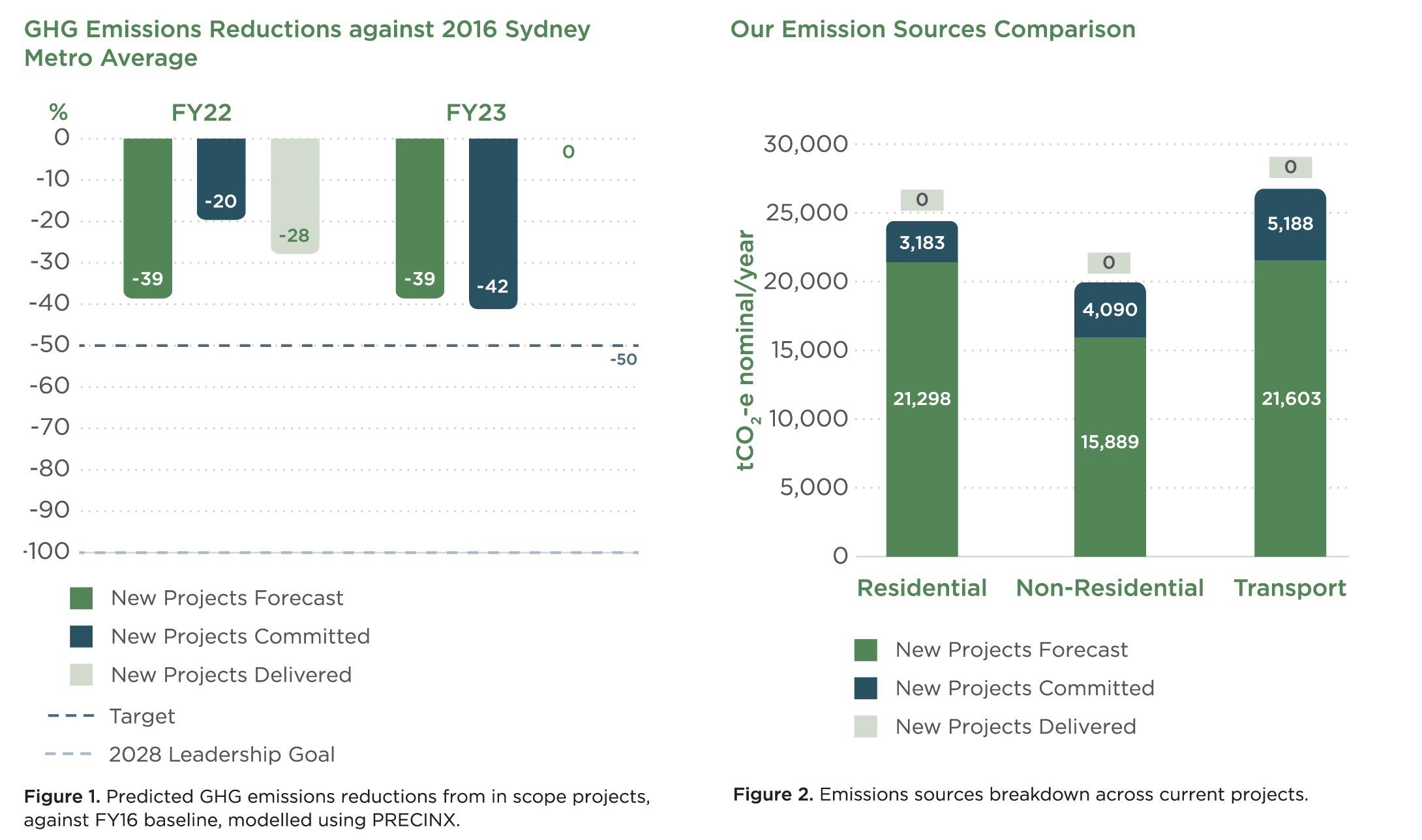
Landcom’s onsite renewable energy target is for 5% of total site demand at the precinct scale to be delivered by onsite renewable energy. This extends beyond the inclusion of solar panels on residential homes and requires a strategic precinct-scale response. The intent of this target is to drive innovation and large-scale integration of renewable energy sources at the project site.
In FY23 Landcom had five projects in scope for reporting. The SMNW Places precincts of Norwest, Hills Showground and Cherrybrook, as well as Macarthur Gardens North have all committed to this target through the inclusion of contract sales conditions. Panorama at North Wilton, while not yet delivered, has committed to this target through the use of a Sustainability Rebate to encourage the purchase of a minimum 6.6kW solar system per dwelling, which has been modelled to generate approximately 107% of the total electricity demand for the community. As lots settle and are built upon, we will update and report these results as delivered.
Environmental Management
Targets
Performance
All projects will adopt the use of industry recognised rating tools at a masterplan and built form scale, achieving not less than ‘Australian Best Practice’ equivalent (Green Star preferred)
Performance
FY22 Performance
64%
achievedFY23 Performance
100%
achievedNABERS: Office, Hotel & Retail – Commitment Agreement or designed to 5 Star Energy and Water
FY22 Performance
100%
achievedFY23 Performance
100%
achievedBASIX Energy
Performance
Detached & Semi – 60
FY22 Performance
0%
achievedFY23 Performance
100%
achievedLow-Rise – 55
FY22 Performance
0%
achievedFY23 Performance
100%
achievedMid-Rise – 45
FY22 Performance
N/A
achievedFY23 Performance
N/A
achievedHigh-Rise – 40
FY22 Performance
100%
achievedFY23 Performance
100%
achievedBASIX Water
All dwellings – 60
FY22 Performance
82%
achievedFY23 Performance
29%
achievedIn FY23, Panorama at North Wilton achieved a 6 Star Communities rating, representing world leadership. The SMNW Places Precincts at Kellyville and Bella Vista are on track to receive a 5 Star Communities rating expected early FY24.
Our SMNW Places precincts at Hills Showground deliver Green Star ratings through condition of sales. The Doran Drive precinct achieved a 5 Star Design & As Built rating, and Precinct East has included a Green Star rating as a requirement in the conditions of sale.
Bulli has been deemed out of scope for a Green Star rating as it is a small site aimed at demonstrating a diversity of housing product on land that was previously an old hospital. Bulli will be an all-electric project and embed sustainability through other mechanisms, such as design guidelines and electric vehicle charging. It is also participating in our research to quantify embodied carbon in existing buildings and comparing the efficiencies of deconstruction and reuse for both carbon and cost. Read more about this in our Case Study: Exploring the benefits and costs of deconstruction.
Landcom had two projects in scope within the reporting period. This included the SMNW Places Precincts of Cherrybrook and Hills Showground. Both precincts have included 5 Star minimum ratings as conditional requirements for contracts of sale.
With the release of new BASIX compliance requirements under the new State & Environmental Planning Policy for Sustainable Buildings, effective from 1 October 2023, Landcom will be refocusing our efforts around BASIX to emphasise improved materials selection. We are therefore retiring our current BASIX targets. Our disclosures for FY23 focus on the simple ways in which Landcom has continued to lead high performance BASIX outcomes, despite this being largely outside of our operational control.
Hillcroft at Claymore, which is being delivered in partnership with Land and Housing Corporation (LAHC), continued to achieve BASIX Energy ratings of 90 for dwellings delivered in the reporting period. This high performance continues to be driven by the installation of solar photovoltaic (PV) systems on homes. The installation of solar PV is something that Landcom and LAHC have been working collaboratively towards over the past few years with new builds including this and where possible, retroactively adding to dwellings already under construction. These homes will provide much needed accommodation to those in need of social housing. High performing, energy efficient and thermally comfortable dwellings result in much lower running costs for residents, which is especially important for vulnerable communities susceptible to the pressures of affordability.
At Macarthur Heights, Landcom continues to honour $15,000 sustainability rebates for the achievement of BASIX 90 home energy ratings. This is part of our effort to make homes more resilient and lower the cost of living for residents via incentives, as we do not have operational control over the dwellings delivered. This year 53 rebate claims were approved with a total investment from Landcom of $361,364.
In FY23, 29% of our dwellings achieved our BASIX Water target, covering Bulli and the SMNW Places precinct of Cherrybrook. All of our dwellings however exceeded NSW minimium BASIX Water requirements. The year‑on-year change between FY22 and FY23 is caused by the divestment strategy of in scope projects. The exceptionally high performance in FY22 was driven by superlot divestment with contractual obligations to deliver on prescribed BASIX Water targets, further aided by the presence of recycled water. In FY23 the performance is based on individual lot sales and no access to recycled water, which significantly diminishes performance.
As we push for higher than compliance with our water target, connections to recycled water and rain tanks become increasingly important in our projects.
Moving forward we are turning our attention to embodied and upfront carbon in materials. Supply chains in construction are deep, sometimes with limited visibility, however we intend to use our influence to drive greater awareness and use of low emissions materials.
Waste & Materials
Targets
Performance
All new projects divert minimum 95% construction waste from landfill (excluding contamination or thazardous materials)
Performance
FY22 Performance
No eligible projects across Landcom delivered worksFY23 Performance
66%
Achieved at projects sold to the private sector100% timber sourced for construction (by cost) is Forest Stewardship Council Certified or agreed equivalent (i.e. Australian Forestry Standards)
FY22 Performance
No eligible projects across Landcom delivered worksFY23 Performance
100%
New projects achieved targetLandcom continues to place a high value on transparently reporting our impact on local environments. We are advancing our approach to focus on how we can achieve net positive environmental outcomes, including zero waste communities.
In FY23 there were three new projects in scope for reporting against our waste diversion target. Hills Showground and Panorama at North Wilton both had contract conditions to deliver on this target, while Norwest had a contract condition to deliver an 80% diversion, however this included demolition waste. Through negotiation, Landcom accepted this as it aligns with best practice under the Green Star tools. We did not have any legacy project contracts that generated material volumes of waste, nor have any new contracts that have started in the reporting period been completed.
We continue to require our contractors to provide their waste report upon completion of works and will report the waste diverted from landfill during the reporting cycle in which the contracted works conclude.
Consistent and accurate waste reporting remains a challenge across the development industry. Throughout the reporting period we tested an online data collection process for waste to mitigate the need for manual ‘paper-based’ workflows. We have slowly rolled this out with projects through contract conditions in FY23 and will continue to do so in FY24.
In FY23 there were three new projects in scope for reporting against our target for 100% Chain-of-Custody Certified timber. These included the SMNW Places Precincts Norwest and Hills Showground, which have used conditions of sale to deliver on this target, while Panorama at North Wilton embedded targets into the civil works contract.
For Panorama at North Wilton, Landcom accepted a minimum contractual target of 95% Chain-of-Custody certified timber, which is deemed equivalent, as it aligns with the Green Star rating credits. As such we are reporting attainment of this target for Panorama and will continue to work towards our target of 100% and report against this again when the civil works are complete.
Water
Targets
Performance
Water Sensitive Urban Design strategy for all projects, pollutant discharge loads not to exceed Nitrogen 45, Phosphorus 65, Suspended Solids 85, Gross tPollutants 90
Performance
FY22 Performance
100%
In scope projects achievedFY23 Performance
100%
In scope projects achievedAll new projects modelled to reduce mains potable water demand by 50% at the precinct scale, against a 2016 reference case (CCAP Precinx)
Performance
Delivered:
Portfolio weighted reduction
39%
No delivered projects
Committed:
FY22 Performance
35%
portfolio weighted reductionFY23 Performance
44%
portfolio weighted reductionForecast
FY22 Performance
50%
portfolio weighted reductionFY23 Performance
54%
portfolio weighted reductionLandcom views water sensitive urban design (WSUD) as integral to the sustainable water cycle management of our projects. WSUD can include the rehabilitation and protection of natural waterways, design elements such as wetlands, rain gardens, water harvesting and storage and efficient fittings, and alternative water sources such as recycled or blackwater.
In FY23, Bulli, Wentworth Point and SMNW Places precinct of Cherrybrook were in scope for reporting against our WSUD target. Hillsborough (legacy project) has also been included in these results. These projects, as well as our existing projects, continue to either achieve or exceed Landcom’s WSUD targets.
As most consent authorities have now adopted similar or enhanced WSUD requirements, this is the last year Landcom will report against WSUD. We will shift our focus to integrated water management as part of our efforts to enable water positive communities by 2028.
Our potable water reduction target seeks to reduce the unnecessary use of potable water and improve the efficiency of potable water that is used. The potable water consumption reported is the predicted operational consumption of a community at completion and is calculated using the sustainability modelling tool PRECINX.
In FY23, Panorama at North Wilton, SMNW Precinct Norwest, Macarthur Gardens North, Queenscliff and Schofields are reported as ‘committed’. The weighted portfolio reduction in FY23 across these projects is 44%. This year on year improvement is largely due to the use of stormwater/rainwater harvesting and recycled water connections at Panorama at North Wilton and Norwest.
During the reporting period there were no ‘delivered’ projects.
We also report our forecast for new projects. Forecast results for FY23 include the SMNW Places precincts of Cherrybrook, along with Wentworth Point, Bulli and Hillsborough. Residential land uses continue to dominate potable water consumption, which is consistent with our operations predominantly as a residential developer (see Figure 3). The weighted average potable water reduction forecast for all forecasted and new projects is 54% (see Figure 4) which is slightly improved on FY22.
The residential component of our new and forecasted project portfolio is forecast to achieve 51% potable water reduction (up from FY22 forecasts), while non-residential water reductions are forecast to improve at 73% reduction. This is an improvement on our FY22 forecast, and is due to improved fixtures connecting to recycled water schemes, and increased inclusion of rain tanks connected to laundry, toilets and irrigation. We expect this to continue to improve year on year as we move towards our 2028 leadership goal.
New projects without access to recycled water or substantial rainwater connections continue to present Landcom with the greatest challenge to meet our targets. Without access to recycled water infrastructure, potable water reductions greater than 50% at the precinct scale become technically challenging, and infrastructure such as private grey and blackwater treatment systems can ultimately have a negative impact on cost of living for our residents.
Despite the challenges this presents there are also opportunities for innovative design, partnership and technology solutions, which we continue to investigate and adopt wherever possible.
